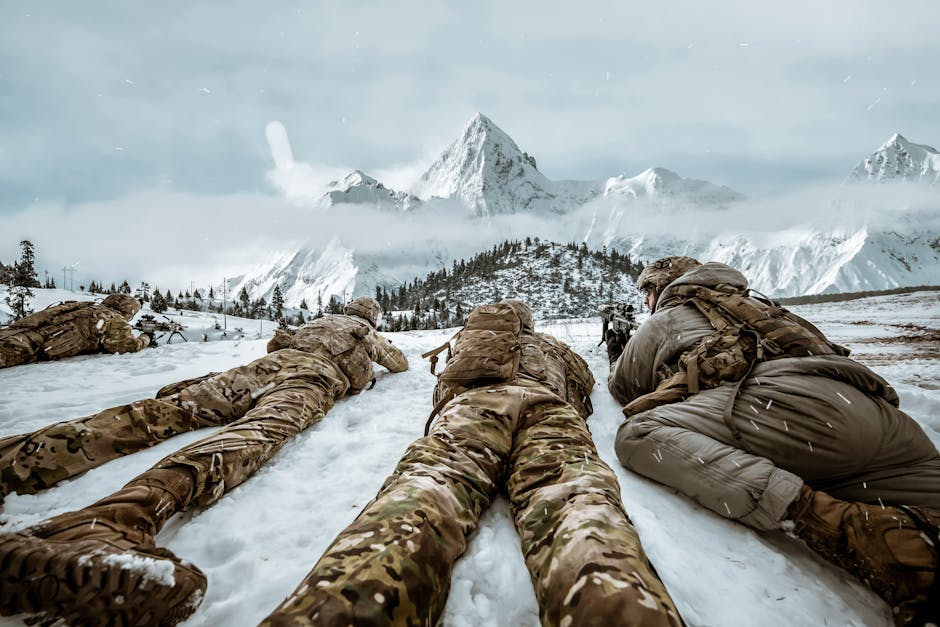
Introduction to Disaster Response Training for Military Members
Disaster response training is a crucial skill set for military members. It equips you with the knowledge and tools to respond effectively to emergencies, from natural disasters like hurricanes and earthquakes to man-made crises. This training prepares you to save lives, reduce suffering, and help communities recover faster. The focus isn’t just on physical readiness but also on understanding the unique challenges these situations present. You’ll learn how to coordinate with other organizations, make quick decisions in high-pressure environments, and provide humanitarian aid alongside security measures. Essentially, it’s about being ready for anything, anytime, anywhere. This training is not optional; it’s a fundamental part of being in the military, reinforcing your role as both a defender and a helper.
Understanding the Importance of Disaster Response in the Military
In the military, being ready for anything isn’t just about knowing how to fight. It’s also about being prepared to help when disasters strike, whether these are natural or caused by humans. When we talk about disaster response, we’re referring to the organized actions soldiers take to help save lives, preserve the environment, and protect property in times of crisis. Disaster response is fundamentally important in the military for several reasons.
First, it demonstrates the military’s commitment to humanitarian aid and support. This kind of action shows that military forces are not just about defense and offense but also play a crucial role in global and community support during tough times. Second, disaster response operations strengthen the military’s ability to operate in diverse and often adverse conditions, making troops more adaptable and skilled. Lastly, it builds trust and fosters good relationships with civilians and the international community. When civilians see military personnel helping to clear debris after a hurricane, delivering food and water in a famine, or setting up field hospitals during a pandemic, it reinforces a positive image of the military.
Understanding the importance of disaster response in the military also means recognizing the unique skills and capabilities that armed forces can bring to disaster zones. These include logistics, communications, and engineering expertise, which are often critical in the aftermath of a disaster. Therefore, disaster response training for military members is not just about preparing them for another aspect of their job; it’s about equipping them with the knowledge and tools they need to make a significant difference in people’s lives when they need it the most.
Key Skills Every Military Member Should Master for Disaster Response
In disaster response, military members play a crucial role, and mastering certain skills can make all the difference. First off, quick decision-making is a must. In a disaster, time is of the essence, and the ability to make fast, effective decisions can save lives. Communication is another key skill. Clear, concise communication ensures teams are on the same page, even in the chaos of a disaster zone. Physical endurance can’t be underestimated either. Disasters require long hours of hard work under stressful conditions, so staying physically fit is important. Also, adaptability is crucial. Disasters are unpredictable, and the ability to adapt to changing situations determines the success of the response efforts. Lastly, medical skills, even basic first aid, are essential. Being able to provide medical assistance can be the difference between life and death. These skills combined equip military members with the tools they need for effective disaster response.
The Role of Leadership in Military Disaster Response Scenarios
Leadership in military disaster response isn’t just about giving orders. It’s about making fast, smart decisions in high-stress situations. The person in charge must assess the situation quickly and set clear, achievable objectives. They guide their team through the chaos, ensuring efficient communication and coordination with other agencies. A good leader inspires confidence, showing calmness and determination. Their actions can boost the morale of their team, helping them to stay focused and effective under pressure. Remember, in a disaster, every second counts, and strong leadership can mean the difference between a successful operation and a failed one. So, understanding and honing leadership skills is crucial for those involved in military disaster response.
Coordination with Civil Authorities and Organizations
In any disaster, military members might find themselves working closely with civil authorities and organizations. This teamwork is crucial. First off, know that local governments hold the primary responsibility for disaster response. As military personnel, your role is to support and enhance their efforts, not overshadow them. Communication is key. You’ll be working with folks from FEMA, the Red Cross, and local emergency services, among others. It’s important to understand each organization’s role and the overall plan. Be prepared to follow the lead of civilian authorities; they call the shots in these scenarios. Also, respect the chain of command and protocols established by civil authorities. Remember, the goal is to provide effective, coordinated aid, not add to the chaos. Your ability to work smoothly with a range of organizations can make a big difference in the success of disaster response efforts.
Specialized Training for Natural vs. Man-Made Disasters
Different disasters need different responses. That’s straightforward, right? For military members stepping into disaster response, it’s vital to understand that natural and man-made disasters aren’t handled the same way. Natural disasters, think hurricanes, earthquakes, or floods, often strike with some warning, allowing for evacuation and preparation. Training focuses on search and rescue, providing medical aid, and ensuring basic necessities like food and water are available.
On the flip, man-made disasters, such as terrorist attacks or industrial accidents, can be unpredictable. The training here gears towards immediate threat neutralization, chemical or radiation decontamination, and crowd control.
So, why does this matter? It’s about saving lives and restoring order efficiently. Knowing the nuances between responding to a flood versus a chemical spill means you can act quickly and appropriately. Plus, this specialized training prepares you to face different challenges head-on, equipped with the right knowledge and skills for whatever comes your way.
Equipment and Technology Essential for Effective Disaster Response
In disaster response, gear and tech make a big difference. Military members stepping into disaster zones need to be equipped with the right kit. First off, reliable communication devices are non-negotiable. We’re talking about satellite phones and radios that can punch through when cell towers are down. Next, navigation tools such as GPS and maps are crucial to not only find your way but also to track and coordinate rescue operations. Personal protective equipment (PPE) like helmets, gloves, and boots shield responders from physical hazards. Also, don’t overlook medical kits stocked with essentials for treating injuries on the fly. Lighting tools, including durable flashlights and headlamps, ensure operations can continue round the clock. Lastly, survival gear—think multi-tools, water purification tablets, and emergency blankets—is a must-have to sustain both rescuers and survivors in harsh conditions. With the right equipment and technology, military personnel can significantly boost their effectiveness in disaster response, turning the odds in favor of saving lives.
Preparing for the Psychological Impact of Disaster Response
When you’re gearing up for disaster response, you’re not just training your body. You’re also prepping your mind. Disaster scenes are tough. You’ll see things that are hard to shake off at the end of the day. It’s not just about being physically ready but being mentally resilient. Know this: stress, anxiety, and even PTSD can come with the territory. It’s all about preparation. Start with recognizing the signs of mental fatigue—things like feeling overwhelmed, restless nights, or just being on edge. Talk about it. Keeping it all bottled up isn’t the answer. And remember, leaning on your team isn’t a sign of weakness; it’s smart. You’re all in this together. Lastly, don’t skip on downtime. Yes, there’s a job to do, but your brain needs a breather to process and reset. Ignoring your mental health doesn’t just mess with your head; it can also knock you off your physical game. Keep sharp, stay aware, and look after each other out there.
Case Studies: Lessons Learned from Past Military Involvement in Disasters
Looking back at history, military units have often been called upon to respond to disasters, both natural and man-made. These engagements offer invaluable lessons. For instance, the response to Hurricane Katrina in 2005 showed the critical need for clear communication and coordination among military units and local authorities. It highlighted the challenge of managing logistics in a disaster zone and the importance of quick action to save lives and restore order.
Another lesson comes from the 2010 Haiti earthquake relief operation. The military’s role in providing immediate medical support and distributing food and water was pivotal. Yet, it underlined the importance of cultural sensitivity and understanding the needs of the affected population.
The Fukushima nuclear disaster in 2011 is another example where the military played a crucial role in evacuating people, providing emergency supplies, and containing the spread of radiation. The operation underscored the necessity for specialized training in dealing with nuclear, biological, and chemical threats.
These case studies illustrate key takeaways for military members involved in disaster response: the need for swift and coordinated action, the importance of communication and logistics, the value of cultural sensitivity, and the requirement for specialized training in various disaster scenarios. Reflecting on these past operations prepares military personnel for future challenges, ensuring they are better equipped to aid effectively when disaster strikes.
Continuous Learning and Improvement in Disaster Response Training
In the military, staying ahead of the curve in disaster response is non-negotiable. Continuous learning and improvement form the core of effective disaster response training. The world’s threats constantly evolve, as do the strategies to manage them. Whether it’s natural disasters or man-made crises, the ability to adapt and respond with the latest knowledge and techniques is critical. This means regular updates to training programs and incorporating lessons learned from past incidents. Real-world events offer valuable insights into what works and what doesn’t. Embracing a culture of continuous learning ensures that military members are always ready, equipped with the most current methods and strategies to save lives and restore stability. Forging ahead, the focus on improvement through post-operation reviews, skill updates, and adapting to new technologies keeps the military’s disaster response capabilities sharp and effective. Remember, in the realm of disaster response, complacency is the enemy; constant learning and adaptation are your strongest allies.

